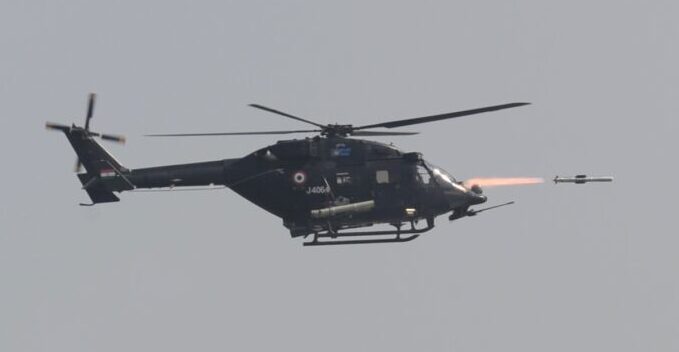Aerospace
Anti-Tank Guided Missile ‘HELINA’ successfully flight tested

The ‘HELINA,’ an indigenously developed helicopter-launched Anti-Tank Guided Missile, was successfully flight tested at high-altitude ranges on April 11, 2022 as part of user validation trials. Teams of experts from the Defence Research and Development Organisation (DRDO), the Indian Army, and the Indian Air Force collaborated on the flying test (IAF).
The missile was successfully fired at a simulated tank target during flight trials from an Advanced Light Helicopter (ALH). An Imaging Infrared (IIR) Seeker working in the Lock on Before Launch mode guides the missile. It is one of the world’s most advanced anti-tank weapons.
The Indian firepower has increased, as one more weapon has been added to the arsenal. Yesterday, the Helina indigenously manufactured helicopter successfully launched anti-tank guided missiles.
Flight tests of the indigenously designed Anti-Tank Guided Missile ‘HELINA’ from an Advanced Light Helicopter were conducted at high altitudes with the involvement of the Indian Army and Airforce.
The Advanced Light Helicopter is equipped with a third-generation fire-and-forget anti-tank guided missile system.
The Defence Research and Development Laboratory in Hyderabad created it.
The Helina, according to DRDO experts, has an operational range of 500 metres to 20 kilometres and can engage targets in both direct hit and top strike modes.
Proof of efficacy at high altitudes, in addition to validation studies conducted in Pokhran, Rajasthan, open the door for its inclusion on the ALH. Senior Army officers and DRDO experts were present during the experiments.
Mantri Raksha Mantri Raksha Mantri Raksha Man Shri Rajnath Singh complimented the DRDO and the Indian Army on their first joint success. Dr. G Satheesh Reddy, Secretary of the Department of Defense R&D and Chairman of the DRDO, praised the teams for their outstanding performance under difficult conditions.
HELINA (Helicopter based NAG) is a third generation fire and forget class anti-tank guided missile (ATGM) system mounted on the Advanced Light Helicopter (ALH). The system has all weather day and night capability and can defeat battle tanks with conventional armour as well as explosive reactive armour. The HELINA missile can engage targets both in direct hit mode as well as top attack mode. HELINA Weapon Systems is being inducted into the Indian Army (IA). A variant of HELINA Weapon System called DHRUVASTRA is being inducted into the Indian Air Force (IAF).

Aerospace
Boeing Transfers Rocket Stage to NASA, Paving Way for Human Moon Mission

Boeing has achieved a significant milestone by providing NASA with the second core stage of the Space Launch System (SLS) rocket.
This crucial component, crafted at NASA’s Michoud Assembly Facility (MAF), is set to propel the Artemis II crew into lunar orbit, marking humanity’s return to deep space after a 50-year hiatus.
The monumental Boeing-built rocket stage, the largest element of the Artemis II mission, will embark on a journey aboard the Pegasus barge, traveling 900 miles to NASA’s Kennedy Space Center.
Comparison of two legendary aircraft B777x vs B747 aircraft:Click here
Upon arrival, it will be meticulously integrated with other essential Artemis II components, including the upper stage, solid rocket boosters, and NASA’s Orion spacecraft within the iconic Vehicle Assembly Building. This intricate integration process is a vital step toward the eagerly anticipated Artemis II launch, slated for 2025.
“Boeing-built products helped land humankind on the moon in 1969, and we’re proud to continue that legacy through the Artemis generation,” remarked Dave Dutcher, vice president and program manager for Boeing’s SLS program. “Together, with NASA and our industry partners and suppliers, we are building the world’s most capable rocket and paving the way to deep space through America’s rocket factory in New Orleans.”
NASA, Lockheed Martin Reveal X-59 Quiet Supersonic Aircraft:Click here
The delivery of Core Stage 2 marks a significant achievement in the evolution of the SLS rocket. Towering over 200 feet and powered by four RS-25 engines, this core stage, coupled with two solid-fueled booster rockets, will generate a staggering 8.8 million pounds of thrust. This immense power is crucial to launching Artemis II and future missions into the vast expanse of space.
The SLS rocket stands unparalleled in its capability to transport both crew and substantial cargo to the moon and beyond in a single launch. Its extraordinary capacity will facilitate the delivery of human-rated spacecraft, habitats, and scientific missions to destinations including the moon and Mars, ushering in a new era of space exploration.
-

 Travel1 week ago
Travel1 week agoAir India to Expand US Operations with Three New Routes After a Decade
-

 Travel2 weeks ago
Travel2 weeks agoWhy We Should Avoid These Stamps in a Passport
-

 Airlines1 month ago
Airlines1 month agoInvestigations Reveal Fake Chinese Titanium in Boeing and Airbus Jets
-

 Tech4 weeks ago
Tech4 weeks agoChina’s CATL Plans 1,800-Mile Electric Plane Launch by 2027
-

 Airport3 days ago
Airport3 days agoTop 10 Largest Airports in the World by Size
-

 Aerospace4 weeks ago
Aerospace4 weeks agoChina’s Fighter Jets Turn Wings into Autonomous Drones
-

 Airlines4 days ago
Airlines4 days agoAir India Rolls Out A350s for Delhi-New York JFK and Newark Routes
-

 Defence3 weeks ago
Defence3 weeks agoBoeing Enhances Chinook with New Engines and Block II Upgrades at $96 Million







